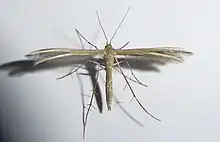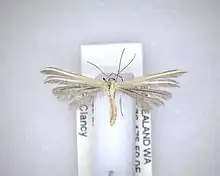Pterophorus innotatalis
Pterophorus innotatalis is a moth of the family Pterophoridae.[4] It is endemic to New Zealand and has been found in the North, South and Ruapuke Islands. Adults of this species have been recorded as being on the wing from October to March as well as in August and prefers to inhabit grass or fern covered hills. The larvae are leaf miners and feed on Dichondra species, including Dichondra brevifolia and Dichondra repens.
| Pterophorus innotatalis | |
|---|---|
 | |
| Scientific classification | |
| Domain: | Eukaryota |
| Kingdom: | Animalia |
| Phylum: | Arthropoda |
| Class: | Insecta |
| Order: | Lepidoptera |
| Family: | Pterophoridae |
| Genus: | Pterophorus |
| Species: | P. innotatalis |
| Binomial name | |
| Pterophorus innotatalis | |
| Synonyms[2][3] | |
| |
Taxonomy
This species was first described by Francis Walker in 1864 using a male specimen collected in Nelson by T. R. Oxley.[5][3] In May 1885 Edward Meyrick placed this species within the Aciptilia genus.[6] In 1913 Edward Meyrick placed Aciptilus furcatalis into the genus Alucita.[7] In 1928 George Hudson discussed and illustrated this species, agreeing with the placement of this species in the Alucita genus.[2] In 1988 J. S. Dugdale confirmed the placement of this species back into its original genus Pterophorus.[3] In 1993 Cees Gielis discussed this species under the name Pterophorus innotatalis but placed it in a list where the species were regarded as having an uncertain status.[8] The lectotype specimen is held at the Natural History Museum, London.[3]
Description
.jpg.webp)

The larvae of P. innotatlis are small and very hairy.[9]
Walker described the adult of this species as follows:
Male. Pale ochraceous, slender. Legs silvery whitish, without any markings. Plumes of the wings extremely narrow. Fore wings unvaried, very acute. Hind wings cinereous-seneous, divided at the base into two plumes. Length of the body 4 lines ; of the wings 10 lines.[5]
Meyrick described the adult of this species as follows:
Male, female. — 15-16 mm. Head, palpi, antennae, thorax, and abdomen pale ochreous. Legs ochreous-whitish, anterior pair internally fuscous. Forewings pale whitish-yellowish, suffused with pale ochreous on anterior half : cilia dark fuscous, becoming yellow-whitish on costa before apex, on lower margin of second segment generally containing a black dot before middle and another beyond middle of segment. Hindwings dark grey ; cilia fuscous-grey.[6]
Distribution
.jpg.webp)
This species is endemic to New Zealand.[1] It has been recorded in the North and South Islands as well as at Ruapuke Island.[2][10] It has been found at altitudes up to 1500 m.[11]
Behaviour
Adults of this species are on the wing from October to March but also in August, causing Hudson to hypothesise that it may have two or more broods a year.[2]
Habitat and host species
P. innotatalis inhabits grass or fern covered hills.[2] The larvae are leaf miners and feed on Dichondra species, including Dichondra brevifolia and Dichondra repens.[9][12][11] The last larval instar feeds on both sides of the leaf of their host species.[9][12]
References
- "Pterophorus innotatalis Walker, 1864". www.nzor.org.nz. Retrieved 2021-12-12.
- George Vernon Hudson (1928), The butterflies and moths of New Zealand, Illustrator: George Hudson, Wellington, p. 210, LCCN 88133764, OCLC 25449322, Wikidata Q58593286
{{citation}}: CS1 maint: location missing publisher (link) - John Stewart Dugdale (23 September 1988). "Lepidoptera - annotated catalogue, and keys to family-group taxa". Fauna of New Zealand. Department of Scientific and Industrial Research. 14: 133. doi:10.7931/J2/FNZ.14. ISSN 0111-5383. Wikidata Q45083134.
- Gordon, Dennis P., ed. (2010). New Zealand inventory of biodiversity: Kingdom animalia : chaetognatha, ecdysozoa, ichnofossils. Vol. 2. p. 463. ISBN 978-1-877257-93-3. OCLC 973607714. OL 25288394M. Wikidata Q45922947.
- Francis Walker (1864), List of the specimens of lepidopterous insects in the collection of the British Museum. XXX: Tineites, London, p. 945, Wikidata Q108264250
{{citation}}: CS1 maint: location missing publisher (link) - Edward Meyrick (May 1885). "Art. XII. — Descriptions of New Zealand Micro-Lepidoptera". Transactions and Proceedings of the New Zealand Institute. 17: 124–125. ISSN 1176-6158. Wikidata Q110063611.
- Edward Meyrick (1913). "A revision of New Zealand Pyralidina". Transactions and Proceedings of the New Zealand Institute. 45: 48. ISSN 1176-6158. Wikidata Q113379622.
- Cees Gielis (1993). "Generic revision of the superfamily Pterophoroidea (Lepidoptera)". Zoologische Verhandelingen. 290 (1): 76. ISSN 0024-1652. Wikidata Q93258703.
- "Pterophorus innotatalis Walker, 1864". plant-synz.landcareresearch.co.nz. 2021. Retrieved 2021-12-12.
- "Pterophorus innotatalis". iNaturalist. Retrieved 2021-12-12.
- Brian H. Patrick (1991). Insects of the Dansey Ecological District (PDF). pp. 1–25. ISBN 0-478-01285-3. ISSN 0113-3713. Wikidata Q110318301. Archived from the original (PDF) on 30 December 2021.
{{cite book}}:|journal=ignored (help) - Hamish J. H. Patrick; Mike H. Bowie; Barry W. Fox; Brian H. Patrick (2011). "The moths of Quail Island (Ōtamahua): a faunal comparison of an island under restoration with other sites on Banks Peninsula". New Zealand Natural Sciences. 36. doi:10.26021/583. ISSN 0113-7492. Wikidata Q97665452.